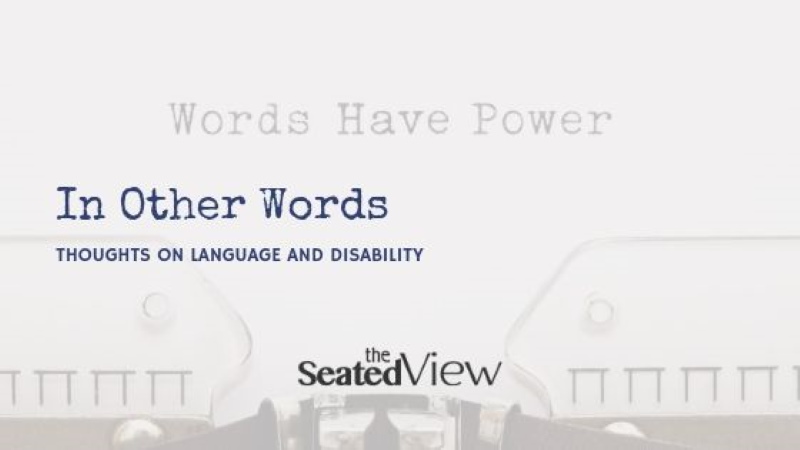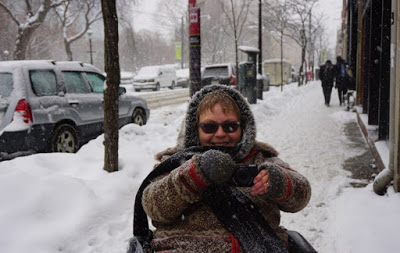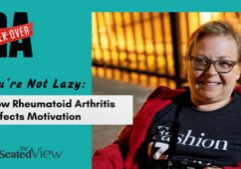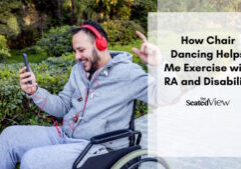In Other Words: Thoughts on Language and Disability

On January 23, someone I know forwarded me a link to an article (now gone) from the Canadian national newspaper the Globe and Mail. The headline “Rheumatoid Arthritis: not the life sentence it used to be” is certainly an attention grabber.
It is a good article. It’s accurate in its discussion of the science and it pays close and detailed attention to the consequences of mistaking RA for osteoarthritis.Although it is perhaps slightly rosy in implying that everyone can go into remission, it is one of the best articles I have seen on the topic in a very long time.
So… what am I on about today, then?

Does this look confined?
I am on about a phrase.
The second sentence of the article is as follows: “Within a month, Cheryl Koehn, a former Olympic volleyball player, was in agony as more than 35 joints in her body became so swollen that she was wheelchair bound.”
Can you guess what phrase I’m about to give a rant? G’head. Guess.
If you said “wheelchair-bound,” you win a prize! Not anything tangible, mind you, but justification for feeling unbearably smug for the rest of the day. We all have days where we need to feel unbearably smug. You can bank it, if you want.
Thirty years ago, when I was in high school in Denmark, we had to do group presentations in English class. One of my friends suggested we do a play about English metaphors and how confusing the language could be. One of the characters in the play was “wheelchair-bound,” so naturally we tied me to my wheelchair with a length of rope.
As is so eloquently stated in the Style Guide to writing about disability at the National Center on Disability and Journalism, “[a] person is not bound to a wheelchair; a wheelchair enables a person to be mobile.” They also describe the phrase “confined to a wheelchair” as inappropriate.
This is because wheelchairs liberate, they do not confine. Without a wheelchair, I would be confined to bed.
One word they do not mention is the c-word. No, not the c-word that no man should ever say to a woman unless he wants to be emasculated. The other c-word. Cripple. Crippled.
Most people, including the media, do seem to get that this is very much not acceptable and I wonder if that is why the Style Guide didn’t include it. Maybe it’s because they assume that no one in their right mind would use that word these days. Except it’s still around. I’ve seen it in several places lately and every time I do, I cringe. Its effect is similar to the n-word when applied to blacks and the f-word for gay men. It has no place in modern discourse, no place in modern media. In fact, these words can really only acceptably be used by the groups themselves as they reclaim these demeaning and destructive words to sap them of their power.
On this side of the border, Human Resources and Skills Management Canada has published A Way with Words and Images: Suggestions for the Portrayal of People with Disabilities. This is a guide to the public and especially to the media. The introduction states “people with disabilities are asking Canadians, and the media in particular, to use respectful terms when writing about them are about issues that affect their lives.” This document is a fantastic resource for those who aren’t sure of the right words to use and includes an excellent list of outdated terminology with corresponding suggestions for respectful language.
Twenty years ago, when I was entering into the employment equity field and acted as a disability advocate in a somewhat different way that I am now, there were several style guides to language about disability going around. At the time, these style guides were offered to organizations and anyone who seemed in need of that and that included the media. Particularly the media. It is so incredibly disheartening that 20 years later, the same language prevails. Much has changed about disability, much has changed about accessibility, but very little has changed in the way the media portrays those of us who live with disability. We are still wheelchair bound. We are still confined to wheelchairs. We are still crippled. We are still “victims of [insert condition here].”
Why does it matter? Because as A Way with Words and Images states so eloquently, “attitudes can be the most difficult barrier people with disabilities face in achieving full integration, acceptance, and participation in society. Since words are a mirror of society’s attitudes and perceptions, we should all put great thought into how we present information about people with disabilities, to help overcome negative attitudes and shape positive ones.”
Accessibility isn’t just about ramps, washrooms, audible fire alarms and texture on the floor. It’s about the language we use to describe each other. Without respectful language, there is no equality.
2 Comments
Read More
Discover what else I've been writing about...
















Lene:
I think this may be one of the most important and informative articles I have read in a year. Thank for writing it and as a result better educating me. I would never use the term 'wheelchair-bound' but frankly I would not do it becuase it seems wrong. But I could not explain wh for certain. Now I know why. Thank you for educating me
Rick
Eloquently put, Lene. Thank you for addressing this ongoing issue–and for providing links to tools we can all use to help us avoid these demeaning and distressing words. They're both in my writing reference list, now. :o)